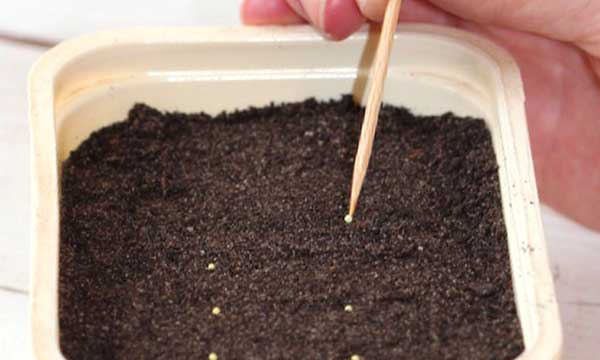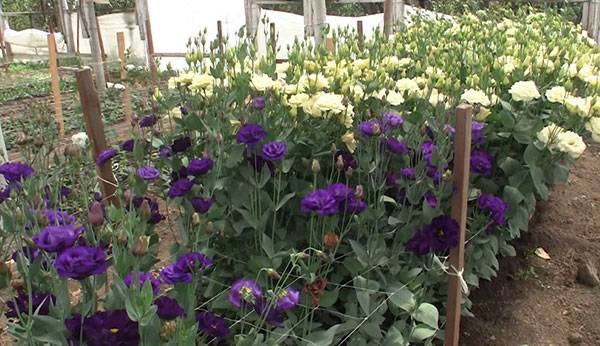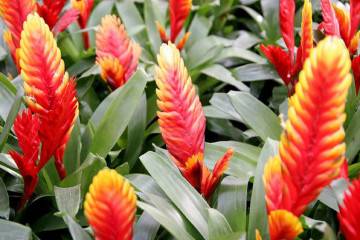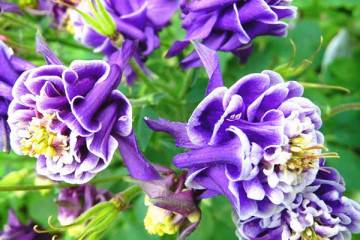Eustoma - growing from seeds at home
Content:
- Reproduction of eustoma
- When eustoma is planted: growing from seeds at home
- Is it possible to grow eustoma as a houseplant
- The choice of capacity and preparation of soil mixture for seedlings
- Presowing seed treatment
- Planting and caring for eustoma at home
- Growing and caring for room eustoma
- Transfer and planting in open ground
- What care does the indoor eustoma require after flowering?
Eustoma (lat. Eustoma, lisianthus) is a flowering plant from the gentian genus with bluish-whitish foliage, as if rubbed with wax, and large tender or double inflorescences in the form of funnels. Inflorescences come in all kinds of shades: white, pinkish, lilac, lilac, with or without a bright border. Until the end, the unopened flowers resemble pink buds, for which the eustoma received another name "Irish rose", and when opened to the end, the inflorescences look just like large poppies. Many inflorescences bloom on one stem, which gives the flower the appearance of a bouquet. The bright, elegant look and long-term storage of cut eustoma flowers annually gains more and more recognition from gardeners. This article describes how to grow an eustoma at home and what kind of follow-up care it will need.
Reproduction of eustoma
Lisianthus is cultivated mainly by seeds, in areas with warm climatic conditions, self-sowing. In the first year, the plant forms a rosette of foliage, in case of a favorable transfer of winter, it blooms the next summer. In temperate climates, it is planted with seedlings, which they buy or sow on their own at home.
It is impossible to propagate eustoma and by dividing the roots, since the flowers do not recover well and do not take root. Unscrupulous sellers under the guise of eustoma offer to buy the roots of other perennial plants (phlox, hosts, etc.). The only sure way to breed eustoma is to sow quality seeds.
When eustoma is planted: growing from seeds at home
Lisianthus has a fairly long growing season before direct flowering. Therefore, it is important to correctly calculate the timing of sowing seeds. On average, the period from the day of sowing the seeds to the first blossoming flowers takes 5-7 months. This period depends on the selected variety and climatic conditions. Therefore, in order for the eustoma to bloom in June-July, it must be sown in the second half of December - early January, the deadline is the first weeks of February.
Is it possible to grow eustoma as a houseplant
Eustoma is considered a perennial (more precisely, biennial), but in regions with a temperate climate, it is planted in flower beds for one season, since it is not able to survive freezing temperatures. For garden plantings, it is recommended to choose the earliest varieties so that they have time to bloom and bloom before the first frost. Flowering for several years will please the same plant grown on a window in an apartment.
The choice of capacity and preparation of soil mixture for seedlings
For sowing seeds, the best option would be a shallow, fairly wide container, for example, a plastic container, with the obligatory presence of drainage holes. In the future, plastic cups with a volume of 100-200 ml are suitable for picking, and 500 ml for final transshipment.
The soil for lisianthus should be neutral acidity, light and loose, so that moisture and air can penetrate well. The best option is a ready-made soil mixture for flower seedlings with an acidity of 6.5-7.0 pH, which will need to be mixed with sifted river sand or perlite to give maximum friability.
In addition, you can independently prepare a soil mixture of 4 parts of peat, 2 parts of garden leaf soil and 1 part of sand with a small amount of ash to neutralize acidity.
Presowing seed treatment
It is recommended to purchase lisianthus eustoma seeds covered with a protective shell (dragee) from specialized departments, as they are very small and inconvenient for planting. Preparation of such specimens is not needed, because they have already been treated with a growth stimulator and fertilizers.
The pelleted seeds germinate only after the complete dissolution of the protective shell. Therefore, during the germination period, it is necessary to ensure abundant watering of the soil, as well as sowing seeds in well-moistened soil. In addition, such seeds are sown as untreated, shallow ones to a shallow depth, since they may not germinate after the shell dissolves.
Planting and caring for eustoma at home
Step-by-step instructions on how to sow eustoma seedlings:
- Pour the soil mixture into a disinfected container with drainage holes, moisten well. Excess liquid will drain into the sump, from which it should be poured.
- In the ground, loosen grooves up to 3 mm deep at a distance of 20-30 mm from each other.
- Arrange the seeds in the grooves using a thin wooden stick dipped in water, leaving a distance of 10-15 mm between them.
- Fill the seeds with dry river sand with a layer of 2 mm so that they are easily visible.
- Moisten the seeds covered with sand with warm, settled water from a spray bottle.
- Create a greenhouse effect by covering the container with cling film, glass hood or plastic bag.
- Place in a warm and well-lit place with an air temperature of 20-25 ° C.
Growing and caring for room eustoma
After sowing, you must adhere to the following recommendations:
- spraying with settled room temperature water every day;
- artificial lighting to extend daylight hours up to 14 hours;
- regular airing in the morning for 20 minutes.
The sprouts appear approximately on the 10-14th day after sowing, after which you need to monitor the level of soil moisture and feed them with stimulating drugs to set the buds. The air temperature of the room during the daytime should be no more than 22 ° С, in the dark - 18 ° С.
The first months, eustoma seedlings need timely prevention of possible diseases. This function is handled by regular watering with a solution of foundationol in a proportion of 1 teaspoon per 1 liter of water.The same drug stimulates the growth and strengthening of seedlings, spraying it with a solution half as much as described in the instructions.
Seedling picking
After 60 days, the seedlings will grow up and get a little stronger, after which they can be dived in separate containers. Care must be taken not to damage the roots of the seedlings, helping yourself with a long knitting needle or tweezers to remove the root system along with the soil. In individual containers with prepared soil, a seedling must be carefully planted in the hole. It should be buried to the bottom leaves and lightly pressed with earth around. Further, the planted sprouts are again placed in greenhouse conditions under film or glass.
Transfer and planting in open ground
Around April (depending on the timing of sowing the seeds), a healthy adult Irish rose is transplanted into large pots by transferring so as not to accidentally damage the roots. In such pots, eustoma grows before flowering as an indoor crop or until the time of planting in open ground begins.
In the second half of May, an adult Lisianthus is ready to plant in open ground without the threat of damage from low temperatures and cold winds. An adult plant ready for transplanting to a permanent place should have 6-8 leaves. It is recommended to disembark by the transshipment method in the evening so that the bright rays of the sun do not scorch the delicate leaves. It is recommended to cover the eustoma with a glass or plastic cap for the first week to adapt to new atmospheric conditions at night. After adaptation, the flowers do not require complex care, they are left to grow in a permanent place.
Caring for a wayward eustoma at home requires certain conditions:
- providing diffused bright sunlight and fresh air: the best option is a room window from the east or west side with the ability to regulate the temperature regime within 19-22 ° С and daily frequent ventilation;
- watering the flower is carried out only after the soil has dried 20 mm deep;
- settled water at room temperature is poured under the lisianthus root, avoiding moisture on the leaves;
- a few minutes after watering, the drained water is drained into the pan;
- spraying an adult plant can lead to the development of foliar diseases;
- top dressing with liquid fertilizers: before flowering - potassium-phosphorus, during the period of green mass gain - organic and nitrogenous;
- remove wilted inflorescences and stems.
What care does the indoor eustoma require after flowering?
After flowering, it is recommended to cut the stems of the eustoma in such a way that no more than 3 internodes remain on each. The cut plant is transferred to a cool place in the house with an air temperature of 10 ° C. During the dormant period, the plant needs rare moderate watering, feeding stops altogether. In the spring, with the appearance of young shoots, the home eustoma is transplanted by transferring it into new soil with micronutrients. The usual watering and care of the transplanted flower is resumed.
Self-cultivation of eustoma from seeds will require a lot of time and patience from the grower, but the luxurious flowering and unobtrusive aroma afterwards will pay off all the effort.
























